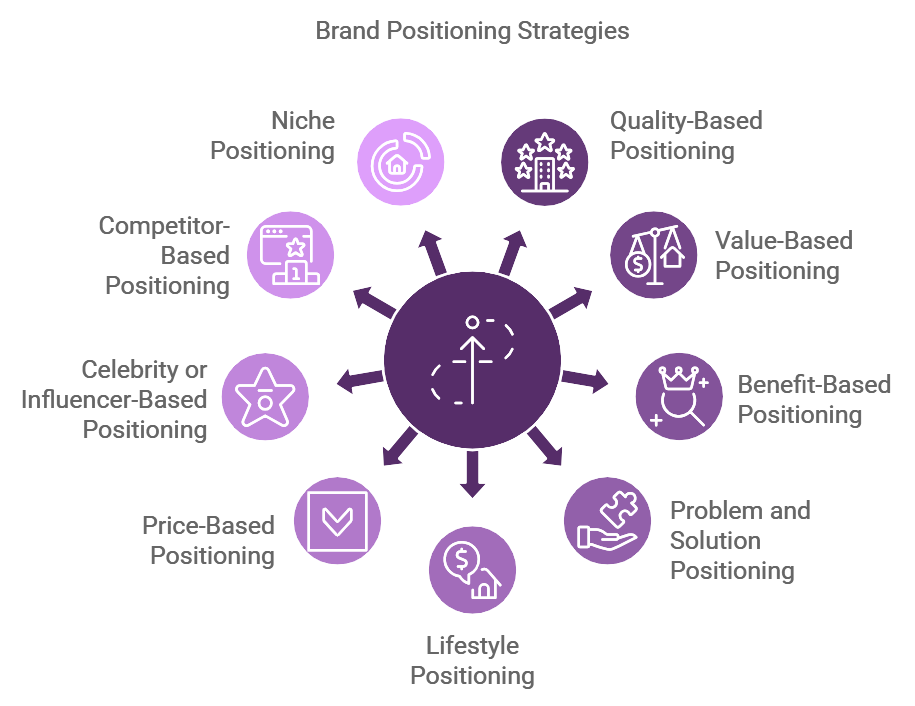Ever wondered why some brands just seem to “click” with their audience while others fade into the background? Often, it’s a result of effective positioning in marketing. Think about it: brands that stand out have made a deliberate effort to occupy a unique spot in consumers’ minds, differentiating themselves from competitors and resonating with their audience’s values. In this blog, we’ll explore the different types of positioning in marketing and how each can be applied to build a brand that captivates and endures.
Table of Contents
What is Positioning?
Positioning in marketing refers to the deliberate, strategic effort to create a unique identity for a brand, product, or service within the consumer’s mind. More than just the product features, positioning is about the emotions, associations, and experiences that a brand conjures up. Essentially, it’s the brand’s promise and the mental space it occupies when you think about a particular product or service.
A great example of this is Dove positioning itself as a brand that celebrates real beauty rather than promoting traditional, unattainable beauty standards. This positioning sets Dove apart from other beauty brands and creates an emotional connection with consumers. Positioning goes beyond attributes—it’s about making a memorable impression that differentiates the brand from competitors.
Why Positioning is Essential?
Today’s consumer landscape is crowded and competitive, making positioning more crucial than ever. But why is it so important?
Differentiation: With countless products offering similar features, differentiation through positioning helps a brand stand out, making it memorable and appealing to a targeted audience.
Building Loyalty: Effective positioning encourages a sense of familiarity and trust. When consumers feel aligned with a brand’s values and mission, they are more likely to remain loyal customers.
Pricing Power: Positioning a brand as premium or high-quality can justify higher price points, making consumers willing to pay more for perceived value.
Consistency in Brand Messaging: Positioning helps align all brand communications, from advertising and social media to product packaging, ensuring that all consumer touchpoints reinforce the desired brand image.
Better Market Penetration: Targeted positioning allows brands to connect more effectively with specific market segments, enhancing product reach and market share.
Also Read: Positioning vs Messaging: Key Differences Explained
Types of Positioning in Marketing
Now, let’s dive into the different types of positioning strategies that brands can use to make an impact.

1. Quality-Based Positioning
Quality-based positioning emphasizes a product or service’s superior quality. This strategy works well for brands that invest heavily in materials, craftsmanship, or processes that contribute to exceptional products.
Example: Lululemon focuses on high-quality, durable, and premium activewear. Its quality-based positioning has helped it build a strong reputation in the athletic wear industry, justifying higher price points and creating a sense of exclusivity.
2. Value-Based Positioning
Value-based positioning targets consumers who are seeking a balance between price and benefits. This strategy doesn’t mean competing on price alone but offering more value for the consumer’s dollar.
Example: IKEA focuses on value-based positioning by offering affordable yet stylish and functional furniture. The brand has built a reputation for making modern design accessible, positioning itself as the go-to choice for cost-effective, quality home furnishings.

3. Benefit-Based Positioning
Benefit-based positioning emphasizes specific benefits or advantages a product offers, solving distinct pain points for the target audience. Brands that choose this approach highlight how their product or service uniquely meets consumer needs.
Example: Head & Shoulders positions itself as the ultimate solution for dandruff, making it the go-to shampoo for consumers with scalp concerns.
4. Problem and Solution Positioning
This strategy highlights the brand’s ability to solve a specific problem, offering a clear and direct benefit to the customer. By positioning themselves as problem-solvers, brands align with customer pain points, presenting their product as the ultimate solution.
Example: Grammarly is a prime example, as it helps users overcome the common problem of grammar mistakes, enhancing communication and professionalism.

Why It Works: Customers often seek products that provide a solution to a specific issue. Problem-solving positioning is effective because it meets an immediate need and builds a loyal following among users who identify with the problem.
5. Lifestyle Positioning
Brands that adopt lifestyle positioning align their identity with a particular way of life, culture, or personality. They don’t just sell a product; they sell an experience or aspiration that consumers want to be a part of.
Example: Patagonia’s brand story revolves around adventure, environmental sustainability, and social responsibility. Customers who value these traits are drawn to Patagonia because it reflects their values and lifestyle.
Why It Works: Lifestyle positioning taps into customers’ emotions and self-identity, creating a bond that goes beyond product functionality and builds strong brand loyalty.
6. Price-Based Positioning
This positioning is primarily focused on being the most affordable or budget-friendly option. However, price-based positioning can be a double-edged sword, as brands need to avoid perceptions of inferior quality.
Example: Spirit Airlines positions itself as the most affordable airline, offering “bare fare” pricing that gives consumers just the basics. While it may lack some luxuries, it appeals to budget travelers looking to save on flights.
7. Celebrity or Influencer-Based Positioning
Leveraging the popularity of celebrities or influencers, this positioning strategy taps into the public’s admiration for certain figures to boost brand appeal. However, authenticity is key, as consumers are increasingly skeptical of forced endorsements.
Example: Fenty Beauty by Rihanna leveraged her influence to connect with diverse beauty consumers worldwide. Her authenticity and commitment to inclusivity helped the brand become a major player in the beauty industry almost overnight.

8. Competitor-Based Positioning
This approach involves positioning a brand directly against a competitor, either by claiming superiority or by filling gaps where the competitor falls short. It can be a powerful tactic, but it requires careful execution to avoid negative comparisons.
Example: Lyft positions itself as a friendly, community-centered alternative to Uber. By emphasizing its driver-first approach and commitment to customer care, Lyft appeals to consumers looking for an ethical and supportive ride-sharing service.
9. Niche Positioning
Niche positioning targets a small, specific segment of the market, focusing on unique consumer needs that larger competitors may overlook. This strategy allows brands to own a specialized space without competing with mass-market giants.
Example: Oatly has carved out a niche in the dairy alternative market by promoting its oat milk as a sustainable and delicious choice. Unlike other dairy alternatives, Oatly targets environmentally conscious consumers and stands out with its unique flavor and origin story.
Crafting Your Positioning Statement
A well-crafted positioning statement is concise, focusing on the brand’s unique value and differentiation. It’s usually just a sentence or two, but it speaks to what the brand stands for and what it offers to its customers.
Here’s a template to help create an effective positioning statement:
“For [target market], [brand name] is the [key point of differentiation] that [main benefit or solution offered]. Unlike [competitors], we [unique feature or approach].”
Integrating Positioning into Marketing Strategy
Know Your Audience: Every positioning strategy starts with a deep understanding of the target audience’s values, behaviors, and needs.
Market Research: Analyze competitors to find gaps and areas where your brand can uniquely stand out. Positioning is about offering something unique that resonates deeply with your target.
Also read: Understanding the Scope of Marketing Research
Consistent Messaging: From advertising and social media posts to packaging, brand messaging should consistently reflect the positioning strategy.
Adaptation Over Time: As markets evolve, so must positioning. Regularly reassess to ensure it remains relevant and compelling.
The Role of Brand Personality in Types of Positioning in Marketing
Brand personality plays a critical role in the types of positioning in marketing because it influences how consumers perceive and connect with a brand on a deeper level. When a brand exudes a clear personality—whether it’s bold, innovative, trustworthy, or playful—it becomes easier to create a positioning strategy that resonates emotionally with its audience. By shaping perceptions, brand personality enriches positioning strategies and creates memorable brand experiences.
Let’s explore how brand personality integrates with the types of positioning in marketing:
- Quality-Based Positioning and Brand Authority: Brands with a quality-based positioning often adopt an authoritative or professional personality. For instance, a premium watch brand might use a classic, refined personality to reinforce its high-quality positioning, which resonates with consumers seeking products associated with craftsmanship and sophistication.
- Benefit-Based Positioning and Empathy: A brand focusing on benefits may adopt an empathetic or helpful personality. For instance, a company offering eco-friendly products might position itself as caring and responsible, aligning with consumers who prioritize sustainable choices.
- Lifestyle-Based Positioning and Aspirational Personality: Brands positioned around lifestyle often take on aspirational or energetic personalities. For instance, athletic brands often use motivating and empowering tones to align with active, ambitious consumers.
- Solution-Based Positioning and Dependability: Solution-oriented brands typically convey a reliable or approachable personality, emphasizing their commitment to solving specific customer issues. A brand offering software for small business growth may adopt a supportive and accessible personality, reassuring users of its reliability.
Why Brand Personality Enhances Positioning Effectiveness
Integrating brand personality with positioning strengthens consumer loyalty and increases brand memorability. By carefully crafting a brand personality that complements the types of positioning in marketing chosen, companies can connect emotionally with their audience, setting a foundation for long-lasting relationships.
Final Tip: As you develop your brand’s positioning strategy, define a clear brand personality that complements it. Whether you want your brand to be seen as luxurious, accessible, or innovative, the right personality can elevate your positioning, making it impactful and unforgettable.
Final Thoughts
In the crowded, ever-evolving world of marketing, the brands that succeed in positioning are those that create an emotional, memorable, and unique place in consumers’ minds. Types of positioning in marketing provide a strategic framework for brands to develop identities that are hard to replicate, delivering value beyond just the product itself. Whether you’re positioning a new product or rebranding an existing one, each type of positioning can help carve out a space that resonates with consumers.
Effective positioning isn’t just about standing out—it’s about standing for something. It’s what makes brands unforgettable, and it’s what keeps consumers coming back for more. So, choose your positioning strategy wisely, let it evolve as your audience does, and create a brand legacy that’s impossible to ignore.

